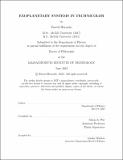Exoplanetary Systems in Technicolor
Author(s)
Berardo, David
DownloadThesis PDF (8.030Mb)
Advisor
de Wit, Julien
Terms of use
Metadata
Show full item recordAbstract
As the number of confirmed extra-solar planets surpasses 5000, our ability to characterize exoplanets has equally advanced in the era of high precision photometry afforded by instruments such as the James Webb Space Telescope. With increased precision, longer baselines of observation, and access to multi-instrument data sets, the study of exoplanets has reached a level of detail never before possible. In this thesis, I focus on the analysis of several multi-planet transiting exoplanet systems observed with the KEPLER, K2, Spitzer, TESS and Hubble instruments. Using data from these instruments, I present a detailed study of the bright HIP41378 five-planet system, extracting the orbital periods of two long-period planets, refining transit center measurements, and detecting Transit Timing Variations (TTVs) of one of the innermost planets in the system, which hints at the presence of an undetected 6𝑡ℎ planet.
Beyond individual systems, I also consider two observable properties of exoplanets at a population-level scale, in the context of treating planets as 3D objects. Measuring the shape of a planet provides us with insight towards their internal structure, formation, and atmosphere, and allows us to disentangle observational degeneracies between surface features and their orbital parameters. First, I expand the study of rotation-induced oblateness to a sample of almost 400 planets, quantifying the detectability of oblateness for these planets in the context of future high-precision observations with the James Webb Space Telescope and other observatories. Next, I examine the observational effects of tidal deformation by the host star of nearly 200 exoplanets, and how current and future uncertainties in the measurement of a planets density allow for such an effect to be detectable. Additionally, I report on the analysis of a large data-set of the TRAPPIST-1 system obtained using the STIS instrument on the Hubble Space Telescope. In keeping with the theme of planets in 3-D, this analysis aims to search for extended neutral Hydrogen exospheres around the TRAPPIST-1 planets, which would appear as transit-like signals in the Lyman-𝛼 emission of the host star.
Finally, I turn to the stars themselves around which exoplanet orbit, considering the effects of non-homogeneous stellar surfaces on exoplanet observations. I investigate how spatially and time varying surface features of a star contribute to baseline trends that must be removed when analyzing exoplanet transits, and assess the feasibility of empirically extracting precise stellar spectra due to star spots, which directly impact the precision of measuring planetary emission spectra. Through these studies, I aim to disentangle higher-order effects and biases which will become prevalent as the quality of observations improves, and to contribute to a more complete understanding of exoplanetary systems.
Date issued
2023-06Department
Massachusetts Institute of Technology. Department of PhysicsPublisher
Massachusetts Institute of Technology